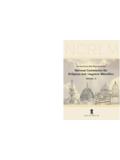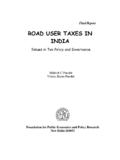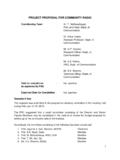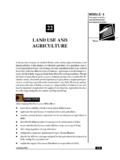Transcription of The Culture and Civilisation of Ancient India in ...
1 The Culture and Civilisation of Ancient Indiain Historical OutlineD. D. KosambiPreface1. THE HISTORICAL The Indian The Modern Ruling The Difficulties Facing the The Need to Study Rural and Tribal The Recapitulation2. PRIMITIVE LIFE AND The Golden Prehistory and Primitive Prehistoric Man in Primitive Survivals in the Means of Primitive Survivals in the Superstructure3. THE FIRST The Discovery of the Indus Production in the Indus Special Features of the Indus The Social Structure4. THE The Aryan The Aryan Way of Eastward Aryans after the The Urban The Epic Period5. FROM TRIBE TO The New The Middle The Buddha and His The Dark Hero of the Kosala and Magadha6. STATE AND RELIGION IN GREATER Completion of the Magadhan Magadhan Administration of the The State and Commodity Asoka and the Culmination of the Magadhan Empire7.
2 TOWARDS The New The Evolution of Political and Economic Sanskrit Literature and DramaPreface IT is doubtless more important to change history than to write it, just asit would be better to do something about the weather rather than merelytalk about it. In a free parliamentary democracy every citizen is supposedto feel that he, personally is making history when he elects representativesto do the talking and to tax him for the privilege. Some have now begun tosuspect that this may not suffice, that all history may terminate abruptlywith the atomic age unless a bit more is done soon. Much that has been talked about India 's glorious past, unhampered byfact or common sense, is even more free than Indian elections. Discussioneddies around obscure dates and deservedly obscure biographies of kingsand prophets. It seems to me that some something more might be achievedin the way of charting the main currents of Indian history, notwithstandingthe lack of the kind of source material which, in other countries, would beconsidered essential by the historian.
3 That, at any rate, is what this bookattempts to do, with the minimum of scholarly display. I am especially grateful to Mr. John Irwin for special advice in makingthe book fit its avowed purpose, in choice of illustrations, and in seeing thework through the press. To him and to Professor A. L. Basham, mygratitude is also due for initiative in finding an English publisher. Janah was kind enough to permit the inclusion of a few of his brilliantphotographs of Indian tribal and rural life, My thanks are due also to MissMargaret Hall for her painstaking revision of maps and drawings; and toMr. Semyon Tyulaev for tracing and photographing illustrative materialin the USSR. Any claim this book may have to originality rests on fieldwork done asa free agent. To those friends and pupils who have shown faith in mymethods and supported them with heart warming enthusiasm, I owe morethan can be expressed in a few 803, D.
4 D. KOSAMBIP oona 4, India ,July 31, ONEThe Historical The Indian Scene A DISPASSIONATE observer who looks at India with detachment andpenetration would be struck by two mutually contradictory features:diversity and unity at the same time. The endless variety is striking, often incongruous. Costume, speech, thephysical appearance of the people, customs, standards of living, food,climate, geographical features all offer the greatest possible Indians may be dressed in full European style, or in costumes thatshow Muslim influence, or in flowing and costly robes of many differentcolourful Indian types. At the lower end of the social scale are other Indiansin rags, almost naked but for a small loincloth. There is no national languageor alphabet; a dozen languages and scripts appear on the ten-rupeecurrency note. There is no Indian race. People with white skins and blueeyes are as unmistakably Indian as others with black skins and dark between we find every other intermediate type, though the hair isgenerally black.
5 There is no typical Indian diet, but more rice, vegetables,and spices are eaten than in Europe. The north Indian finds southern foodunpalatable, and conversely. Some people will not touch meat, fish, oreggs; many would and do starve to death rather than eat beef, whileothers observe no such restrictions. These dietary conventions are notmatters of taste but of religion. In climate also the country offers the fullrange. Perpetual snows in the Himalayas, north European weather inKasmir, hot deserts in Rajasthan, basalt ridges and granite mountains onthe peninsula, tropical heat at the southern tip, dense forests in laterite soilalong the western scarp. A 2,000-mile-long coastline, the great Gangeticriver system in a wide and fertile alluvial basin, other great rivers of lessercomplexity, a few considerable lakes, the swamps of Cutch and Orissa,complete the sub-continental picture.
6 Cultural differences between Indians even in the same province,district, or city are as wide as the physical differences between the variousparts of the country. Modern India produced an outstanding figure ofworld literature in Tagore. Within easy reach of Tagore's final residencemay be found Santals and other illiterate primitive peoples still unaware ofTagore's existence. Some of them are hardly out of the food-gatheringstage. An imposing modern city building such as a bank, governmentoffice, factory, or scientific institute may have been designed by someEuropean architect or by his Indian pupil. The wretched workmen whoactually built it generally use the crudest tools. Their payment might bemade in a lump sum to a foreman who happens to be the chief of their smallguild and the head of their clan at the same time. Certainly these workmencan rarely grasp the nature of the work done by the people for whom thestructures were erected.
7 Finance, bureaucratic administration, complicatedmachine production in a factory, and die very idea of science are beyondthe mental reach of human beings who have lived in misery on the marginof over cultivated lands or in the forest. Most of them have been driven byfamine conditions in the jungle to become the cheapest form of drudgelabour in the city. Yet in spite of this apparent diversity, there is a double unity. At dietop there are certain common features due to the ruling class. The class isthe Indian bourgeoisie, divided by language, regional history, and so on,but nevertheless grouped by similarity of interests into two and mechanised factory production are in the hands of the realcapitalist bourgeoisie. Distribution of the product is dominated primarilyby the petty-bourgeois class of shopkeepers, formidable by reason of theirlarge number. Food production is overwhelmingly on small plots.
8 Thenecessity of paying cash for taxes and factory goods forces the peasantinto a reluctant and rather backward wing of the petty-bourgeoisie. Thenormal agrarian surplus is also in the hands of middlemen and money-lenders who do not generally rise into the big bourgeoisie. The divisionbetween the richest peasants and moneylenders is not sharp. There arecash crops like tea, coffee, cotton, tobacco, jute, cashew, peanuts, sugarcane,coconuts and others tied to the international market or to factoryproduction. These are sometimes cultivated by modern capitalist ownersby mechanised techniques on large plots of land. High finance, oftenforeign, determines their prices and skims off the main profit. On the otherhand, a considerable volume of consumer goods, especially utensils and textiles,is still produced by handicraft methods and has survived competition with factoryproduction.
9 The political scene is dominated entirely bythese two sections of the bourgeoisie, with a class of professional (lawyers,etc.) and clerical workers as the connecting link with the legislatures andthe machinery of administration. We must note that, for historical reasons, the government is also thegreatest single entrepreneur in India . Its assets as a large capitalist equalthose of all private Indian capitalists together, though concentrated inparticular types of investments. Railways, air services, posts and telegraphs,radio and telephone, some banks, life insurance, and defenceindustries are entirely in the hands of the state, as to some extent are theproduction of electricity and coal. Oil wells are state owned. The major oilrefineries are still in the hands of foreign companies, though state refinerieswill soon be in full production. Steel was mostly in private ownership, butthe state has begun its own large-scale iron and steel production.
10 On theother hand, the state does not produce food. When scarcities (often artificiallycreated by shopkeepers or middlemen) threaten to drive cheaplabour out of the cities the state distributes imported grain by rationing inthe major industrial centres. This satisfies both the large and the pettybourgeoisie without interfering with the profits of either. The obvious cureand stabiliser for the uncertain food situation would be to collectagricultural taxes in kind, with storage and distribution of food effectively inthe hands of the government. Though suggested often enough--andindeed the practice in Ancient India nothing has been clone in thisdirection. The imported grain is neither unloaded by efficient suctionpumps nor stored in modern grain elevators, nor even mechanicallycleaned. The production of consumer goods is in private hands. Stateinterference is necessary even here for two reasons.








